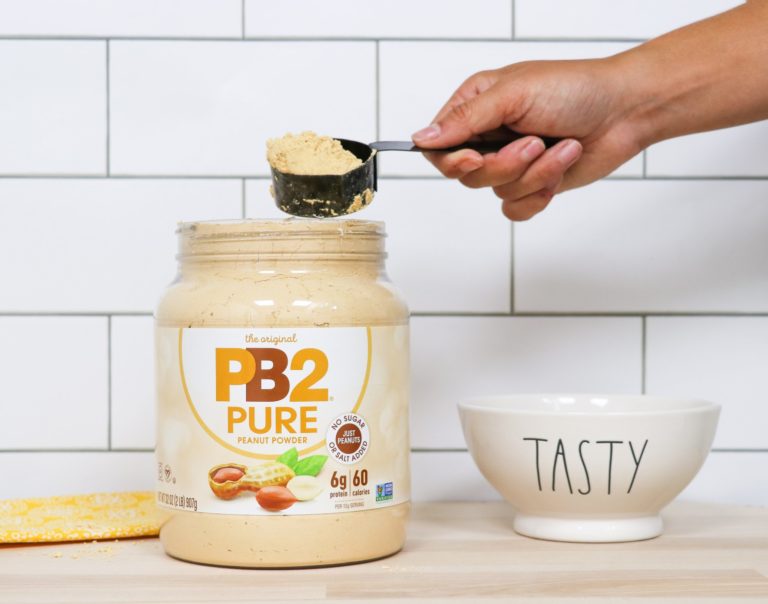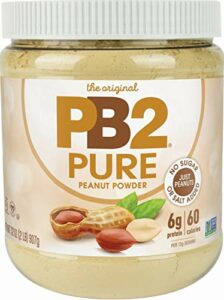
Roasted peanuts are ground into a fine powder, then the natural oils are extracted, and the powder is created. You’ll get an 85 percent lower-calorie powdered peanut product that still packs a lot of taste. Use it as a dry powder or mix it with water to create a paste. Others worry about the nutritional repercussions of eliminating the oil from peanuts from PB2, which some consider a low-calorie alternative for peanut butter enthusiasts.

Contents
How Many Calories Are Present In Pb2?
- Total Fat 1.5g 2%
- Total Carbohydrate 5g 2%
- Dietary Fiber 1g 4%
- Total Sugars 2g
- Added Sugars 1g 2%
Here you can find the detailed chart for pb2 nutrition facts for reference.
Also, if you are looking for a healthy breakfast and at the same time, a delicious one then pb2 is the right choice for you.
27 Must Know Pb2 Nutrition Facts
- Due to removing most lipids, powdered peanut butter is much lower in calories than regular peanut butter.
- Only 45 calories in two tablespoons of PB2 compares well to two teaspoons of natural peanut butter (1, 2).
- According to recent research, as a source of fibre and protein, PB2 may help manage hunger.
- Anyone seeking a quick method to cut calories or on a calorie-restricted diet may benefit from powdered peanut butter.
- Despite their high calorie and fat content, peanuts have been demonstrated in studies not to affect weight gain when consumed consistently.
- Perhaps because nuts make you feel full and satisfied after a meal, you eat less of other foods throughout the day as a result.
- Nuts may also help the body burn more calories when at rest, although this hasn’t been shown in all research. It’s time for further investigation.
- Remember that commercial peanut butter may include other vegetable oils. Powdered peanut butter may be the superior option when it comes to your waistline. Traditional peanut butter has 16 grams of fat per two tablespoons. However, PB2 has only 1.5 grams of fat in the same amount.
- On the other hand, Peanuts contain primarily unsaturated fats, usually regarded as good for your health.
- Peanuts’ primary fat type, oleic acid, has been shown in studies to lower blood pressure, reduce inflammation, and cut heart disease risk.
- A lack of monounsaturated fats may result from eating PB2 instead of full-fat peanut butter.
- Alternative sources of monounsaturated fat, such as olive oil, may or may not be an issue.
- Concerns have been raised about losing fat-soluble vitamins from powdered peanut butter.
- However, peanut butter provides a considerable amount of vitamin E, a fat-soluble vitamin. The RDI for two tablespoons is 14%.
- It is a fat-soluble vitamin, and a natural antioxidant in the human body. Antioxidants can minimize inflammation and cellular damage by fighting free radicals.
- Analysis of peanut flour, a product comparable to PB2 in terms of vitamin E concentration, compares to the nutrition facts label for PB2.
- Null fat and no vitamin E are found in defatted peanut flour, prepared by grinding up defatted peanuts.
- Powdered peanut butter is unlikely to be a valuable source of vitamin E anymore since the lipids in PB2 have been eliminated.
- ACCORDING TO A RECENT STUDY, Vitamin E deficiency affects up to 80% of adolescents and adults.
- It’s possible that for folks who aren’t currently eating a lot of vitamin E-rich dietary sources, peanut butter may be the superior option.
- Powdered peanut butter lacks the creamy texture and rich taste of regular peanut butter, removing most fat.
- Small quantities of sugar and salt enhance the final product’s flavour.
- Due to its low sugar content, it is unlikely to contribute much to your daily sugar intake unless you consume vast amounts of it.
- On the other hand, traditional salted peanut butter typically includes 147 mg of salt per serving, while 94 mg of salt is present in PB2. Other powdered peanut butter brands may offer sugar- and salt-free versions, but PB2’s original and chocolate flavours have a small amount of sugar and salt added to the recipe.
- It is not advised because of the increased danger of choking associated with traditional peanut butter for the elderly or children under four.
- This is because its sticky nature makes it a potential choking danger.
- Traditional peanut butter must be softened with water before it can be offered to these people. It may either be spread on or mixed with meals.

Some Other Details About Pb2 Nutrition
- Traditional peanut butter may be replaced with PB2 powdered peanut butter with fewer calories and fat.
- This may be an excellent choice if you’re on a rigorous calorie-restricted diet.
- Consuming it in moderation may be prudent since it contains added sugar and salt.
- PB2 may be a safer option to nut butter for persons prone to choking due to its ease of thinning or stirring into liquids.
- Due to its highly processed nature, some of the peanuts’ nutrients have been lost. It has fewer monounsaturated fats and less vitamin E than conventional peanut butter.
- Traditional peanut butter may be preferable for most individuals since PB2 is less nutritious than conventional peanut butter, which is connected to several health advantages.
Summary
In conclusion, PB2 is a low calorie, low fat peanut butter alternative made by removing most of the oil content and replacing it with dehydrated peanuts. It is a good source of protein and contains no added sugars or artificial ingredients. It is a healthier option for those who are looking for a lighter peanut butter option, but still want to enjoy the flavor and benefits of peanut butter. Keep in mind that it may not have the same texture or flavor as regular peanut butter, but it still offers a variety of nutritional benefits.
